Did George Hodel in His 1966 Zodiac Cheri Jo Bates "Confession Letter" Use the Term "Blue Eyed Brownett" Based on His Former Training as a Newspaper Crime Reporter?
August 7, 2016
Los Angeles, California
Zodiac’s unique sounding description of his potential future victim to be a “Blue Eyed Brownett” is not so unique after all. The identical description has been found in several newspaper articles written by reporters across the nation in the Fifties and Sixties, and likely existed and was used much earlier.
We know that George Hodel, as the 1947 “Black Dahlia Avenger” used his training as a Los Angeles Record crime-reporter to write his cut-and-paste headline taunts when he mailed in his letters to the press and police. He wrote:
“Dahlia’s Killer Cracking Wants Terms”
“‘Go Slow’ Man Killer Says Black Dahlia Case”
Did George Hodel also call upon his early journalistic training twenty years later, in 1966, in his taunting letter mailed to the press and police? On the one-month anniversary of the brutal stabbing murder of Cheri Jo Bates, the 18-year-old college student, in Riverside, California, Zodiac mailed in his ‘Confession Letter.”
It would appear so. Here is what I have discovered.
A 1956 article in a New Mexico newspaper references an FBI APB (All Points Bulletin) for a Los Angeles couple wanted for counterfeiting. The article names Herbert Dennis Bechtel age 40, with an extensive police record and several aliases, along with his wife, Lena Mae Cox, who the journalist describes as “an attractive blue-eyed brownett” in her early 30s. (See below)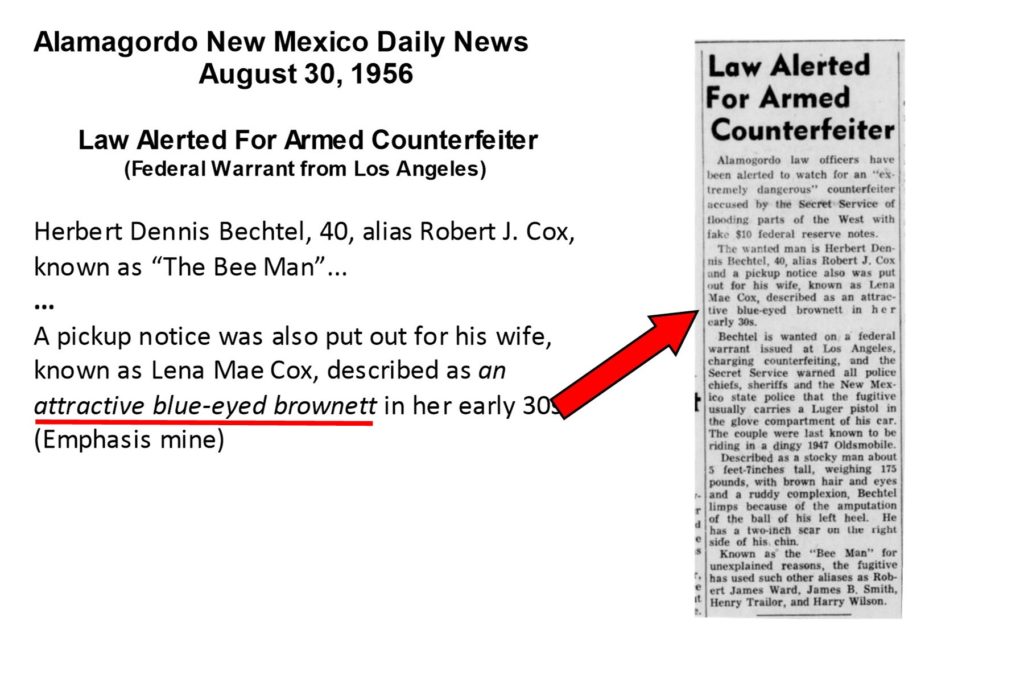
Then on September 19, 1966, just five weeks before the Cheri Jo Bates murder in Riverside, California, two front page articles appeared headlined in The Dispatch, a Lexington, N.C. newspaper.
The lead story read, ” Over 3,000 Attend “Erlanger Day”
The article displayed a photograph of an attractive young woman and went on to say, “Judy Hegler Crowned Queen”; Judy Hegler, 17, a blue-eyed brownett and a 1966 graduate of Lexington Senior High won the honor in competition with six other lovely young ladies, all daughters of Erlanger employees.”…
Also featured on the front page, immediately below the “blue eyed brownett” description was a separate and unrelated story, describing the horrific bludgeon/stabbing murder of a young woman in Chicago, Illinois.
The victim was Valerie Percy, age 21, the daughter of Republican senatorial candidate Charles H. Percy. The murder would become major news in all of the Chicago newspapers and went on to describe how a burglar broke into the family estate while all family members were asleep. The suspect after forcing entry then went to the victim’s bedroom where he attacked and savagely stabbed her to death. He left without taking any property and though thousands of man hours would be spent attempting to identify the killer, fifty years later, the Valerie Percy case still remains an unsolved murder.
(SKH Note: The Valerie Percy murder occurred just eight miles north of where George Hodel’s three “Lipstick Murders” were committed in 1945 and 1946. All of those crimes were nighttime burglaries of occupied residences where the victims were attacked while sleeping and then stabbed to death. In one instance, Suzanne Degnan, a six-year-old child, was carried from the home and her body surgically bisected in a nearby basement, then the body parts were spread out in drainage sewers in the neighborhood, “for the whole city to see.”)
See related headlines on Valerie Percy murder below.
carbondalesouthernillinoisan-19670827-26
jacksonvillecourier-19660919-1
1966 Zodiac Cheri Jo Bates “Confession” Letter which includes his description of a “BLUE EYED BROWNETT.” (Red underscored.)
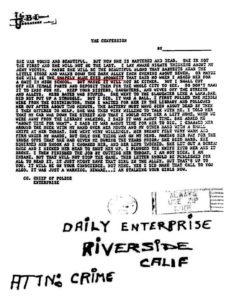
…OR MAYBE SHE WILL BE THE SHAPELY BLUE EYED BROWNETT THAT SAID NO WHEN I ASKED HER FOR A DATE IN HIGH SCHOOL…
…
…BUT I SHALL CUT OFF HER FEMALE PARTS AND DEPOSIT THEM FOR THE WHOLE CITY TO SEE.*
*(SKH Note- George Hodel did exactly that in the 1946 Suzanne Degnan murder, and in the 1947 surgical bisection murder of Elizabeth “Black Dahlia” Short, as well as repeating it a third time in his 1967 Manila, Philippines surgical bisection murder of victim Lucila Lalu, whose body parts (like the Degnan and Black Dahlia murders) he “deposited for the whole city to see.”
(SKH Note): The initial 1956 article describing the suspects in a “major counterfeit ring” appeared in the LA Times two days prior to the article referenced in the Alamagordo NM Daily News.. Below is the LA coverage of the above mentioned Herbert Bechtel and his wife, Lena Mae Cox, referred to as “the attractive blue eyed brownett.”

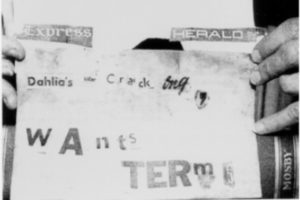
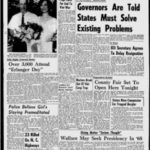

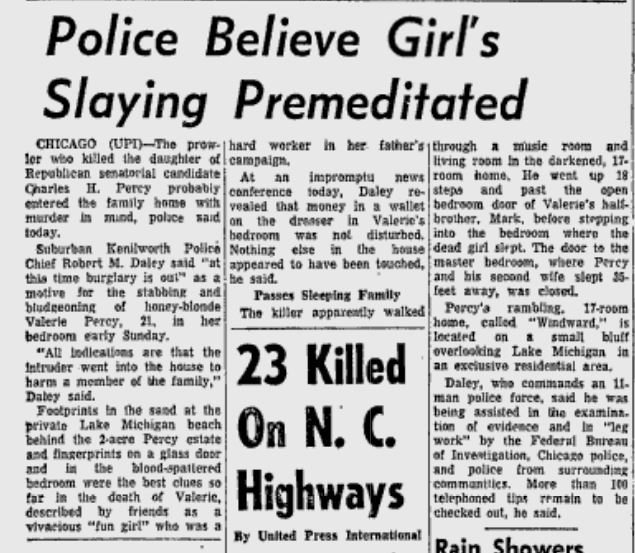
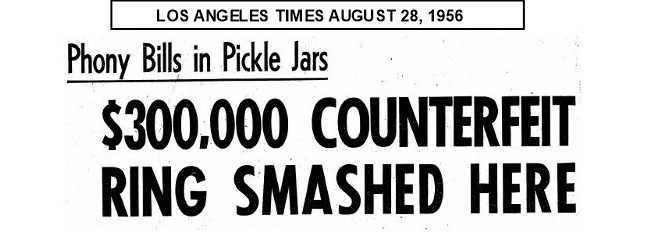
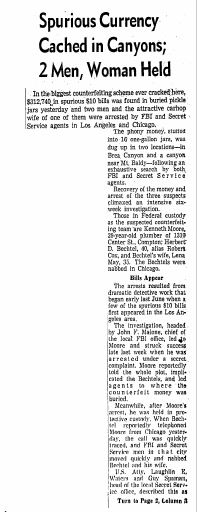


Hmph. Yet another thread tugged on a bit harder. Very odd phrase. Sounded contrived when I first read it. Apparently, it had some legitimacy as a descriptive term. “Brownette?” Not Brunette? When were the two different.
Chuck Percy was US Senator for Illinois for many years. I never knew of this tragedy. Very, very sad. The odds are even it was GHH.
Hi JR: Yes, even down to the unusual spelling BROWNETT. Never even considered the possibility that GHH would also “return to the scene of his crimes in Chicago in the Sixties,” but based on what we know of his MO and Crime Signatures from the Red Lipstick Murders of the Forties, certainly have to consider it as a possibility. I had never heard of the Percy murder, but obviously, it was huge news back then and just a few weeks before his murder in Riverside, certainly gives cause to question it.
Your father’s genius for murder was how he selected his victims and the scene, and escaped with no trace. The fact that this crime was specifically a murder, with no burglary or any other types of associated crime, would place your father has a significant suspect. Its exactly his style, and, as you point out, he was active at that time in a ferocious fashion.
So yet again, you go looking for one thing and you somehow find another. I would imagine if that case were still open, you would find even more of your father’s signatures.
I know statistics can be run off of cold cases, but is there any way of running a search based on your father’s parameters, to identify potential victims during certain time frames? He definitely had his MO down well.
Steve: Per a recent article entitled “Makeup Forever” in “The Paris Review,” the term “brownette” was coined by Max Factor in the late 1920s. The article calls it an “antiquated concept,” although it looks like the term is still occasionally used today. There is a “Brownette Room” at the Hollywood Museum on Highland. Even in 1966 the usage was distinctly retro. -LW
LW: Sounds right to me. Likely from GHH’s day’s as a crime reporter for the L.A. Record in 1924-25. Love to find one of his articles back then where HE actually used the term. That would be a nice little thoughtprint. Have to check out the Max Factor “Brownette Room” and maybe get a photo the next time I’m having lunch at Musso and Frank Grill, which is just down the street.
skh
In BDA, you wrote that Elizabeth’s one-time roommate Linda Rohr worked at Max Factor in the Rouge Room.
Jean Spangler was a “shapely blue-eyed brownett” as well. The term does seem to evoke old-style Hollywood glamor.
Steve: I guess Zodiac was just evoking a bit of that old-style 40s Hollywood glamour as he warmed up to his topic of shapely young blue-eyed brown-haired women whose female parts he’d cut off and display for the whole city to see. “Dahlia killing was justified’ – “Bates had to die” – check, got it! -LW
Steve: A few other general points about Zodiac can be gleaned from the “Confession” letter, including: (1) He has a sly, absurdist wit; (2) he’s a very proficient typist and probably used a typewriter extensively in his day job; (3) judging by his use of formal, academic/business English (“during the years prior”) he’s an educated, professional person. -LW
Steve: Your father was ahead of his time. Today it would be called “trolling.” “YOU WOULD NOT GIVE ME A SQUARE DEAL” (BDA) – “IT WILL BE ON YOUR CONSCIENCE, NOT MINE” (Zodiac). ROFL, no doubt. -LW
Hi Steve,
In re the line “you would not give me a square deal” from the BDA letters, I just ran across an image of an LA Evening Herald front page covering ‘Kid’ McCoy’s 1924 murder trial. The headlines: M’COY IN TEARS AT SANITY TESTS – FORMER MERCILESS FIGHTER BREAKS DOWN AT PROBE AND ASKS ‘SQUARE DEAL.’ As a 16-yo crime reporter for the LA Examiner, GHH files the bizarre, fetishistic dispatch from the Teresa Mors death scene which you present in BDA. At McCoy’s colorful trial (where Damon Runyon appears for the defense as a character witness) a young Jerry Geisler, who 25 years later would get your father off the hook for incest and child molestation, acts out a preposterous dramatization of McCoy struggling with Mors over a gun to prevent her from committing suicide. Between the uncertainty created by this exculpatory scenario, Geisler’s playing up the “star-crossed lover” angle to his hand-picked, largely female jury, and McCoy’s subsequent feigning of insanity, McCoy is out of jail by 1932. This history might go some way to explaining GHH’s lighthearted attitude towards the criminal justice system.
Best regards,
LW
Steve:
Just finished reading Ben Hecht’s “Fantazius Mallare: A Mysterious Oath” (1922), one of GHH’s boyhood favorites. You have discussed it fairly briefly in your books. Like GHH’s early murder scene dispatches and his “Inference” poem it seems worth revisiting in the context of the Zodiac crimes.
Background… Fantazius is a partially first-person account of an artist’s descent into madness and murder. Hecht ran into trouble with the censors on account of its obscene content and illustrations. The major literary inspiration was “A rebours,” by J-K. Huysmans (another of GHH’s favorites), itself said to have been model for the Decadent novel which corrupted Dorian Gray in Oscar Wilde’s story. Hecht is also reported to have modeled Mallare on John Barrymore (star of “Dr. Jekyll and Mr. Hyde”), a fellow member of the Bundy Drive Boys (the “Hollywood Hellfire Club”). Interestingly, I see that Will Fowler (newsman at Black Dahlia crime scene) was another member of this notorious band of hell-raisers.
The book itself… If one were to do a “word cloud” of the novel, the word “red” (red dress, red hands, red face, red room, etc.) would be way up there, as would the word “phantom.” Some thought prints from the book: (1) megalomania combined with misanthropy, toying with the notion of suicide but concluding that the destruction of others is the road back to Godhood; (2) desire to create and rule a world in which others are tormented and the idea that one dominates one’s victims after they die; (3) the idea that insanity might be a preferred state; (4) egotistical resentment that words are defined by others and impulse to reassert superiority by inventing one’s own words; (5) solipsism and inability to distinguish dream and reality; (6) erotomania combined with misogyny based on resentment of female sexual power; (7) obsessive documentation of inconsequential banalities. Of Wallace Smith’s illustrations, the first depicting an emaciated male figure having coitus with a female tree spirit strikes me as interesting w.r.t. interpretation of the Zodiac Halloween card.
Is there any chance you could present the entirety of GHH’s review of Hecht’s sequel, “The Kingdom of Evil?” Personally, I find the question of GHH’s early Symbolist/Decadent influences at least as interesting as the later Surrealist/Dadaist material.
Regards,
LW
Addendum: Here are some lines and passages I highlighted as of particular interest w.r.t. to Zodiac in Fantazius Mallare:
“I saw a man with a red face,” he would write one week. The next he would add a line, “There are seven hundred and eighty-five normal strides between the lamp-post and my front door.” Turning a page a month later he would meticulously set down the date, the hour of the day, the direction of the wind and under it write out, “I have a stomach ache from eating peaches.”
An intolerable loathing for life, an illuminated contempt for men and women, had long ago taken possession of him. This philosophic attitude was the product of his egoism. He felt himself the center of life and it became his nature to revolt against all evidences of life that existed outside himself.
In a manner it was not Mallare who became insane. It was his point of view that went mad. Although there are passages in the Journal that escape coherence, the greater part of the entries are simple almost to naiveté.
My room is red. It is hung with red curtains. I have bought only red things to put in it. The sun coming through my red curtains reddens the air of the room.
“Yes, I ought to have been a God. I should have had my way with people then. I could have created a world whose horrors would have remained a consoling flattery to my cynicism.”
To return thus to Godhood means to destroy All.
I feel words like rivals in my head. Alas, I must think in words. Words are the inevitable canonizations of life. But worse, they are property loaned me and not my own. I must have my own and live with it entirely. Yet there is some comfort in words. They are not entirely sullied by their promiscuity. Words are like nuts people pass each other without ever opening. The insides of words are often virginal.
“After you are dead I will continue to enjoy for a time the uninterrupted image of you. You will haunt my thought until you grow dim. But I will possess the vanishing shadow…. But now you die.”
“Poor Rita,” he continued. “No longer dangerous.” [after murdering a random stranger in an hallucinatory rage]
“Ah, what loathsome and lecherous mouths women are! Offering their urine ducts as a mystic Paradise! Stretching themselves on their backs and seducing egoists with the unctuous lie of possession. The mania for possession—that most refined of all instincts—the most heroic of insanities! How easily they circumvent it! To desire is merely to love. But to create in oneself the objects of desire—that is to be mad and above life. Beyond it.
My memory is innocent.
She was dressed in a gown I had never seen before. It was red.
A paradise in which I might strut alone.
Let us study the phenomenon of red hands.
LW: Yes, no question GHH as Zodiac aka “The Red Phantom” was fixated on the color red. Here is an excerpt from BDA (1st ed. 2003) before we knew the definite connection of the maid, Ellen Taylor and discovered the DA Tapes post-publication.
BDA: Chapter 20: The Franklin House Revisited
Extract from October, 1999 interview with the then owner of the Franklin/Sowden House. At that time to protect his privacy in BDA I gave him the pseudonym of “Bill Buck”.
Another strange incident: Buck told me about the appearance of a “bag lady” who came to the door back in the 1970s or early’80s. “She looked quite old,” he said, “but with street people it’s hard to tell.” I spoke with her and she said, ‘This house is a place of evil.’” He said that normally he would have simply dismissed her, but then she continued to describe the interior of the house. “It was very scary,” he said. “She obviously had been inside this place before we owned it. She described in detail to me: the great stone fireplace, and your father’s gold bedroom, and the all-red kitchen that your father had painted. No question that she was very familiar with the house when your dad had lived here. She looked at me and said again, ‘This is a house of evil.’ God knows what connection she had with this place. She left, and I never saw or heard from her again.”
Based on a conversation I had with former tenant Joe Barrett, it is my belief that the person Buck described as a “bag lady” was most probably our former maid, Ellen Taylor, Father’s live-in housemaid/girlfriend, who lived at Franklin House from 1945 to 1950. In later years, Joe Barrett had run into Ellen on the street in downtown Los Angeles and discovered that she had been in and out of mental hospitals. Joe Barrett described her as “living on the fringe, delusional, claiming she had had affairs with a number of prominent and locally famous personages.” (Knowing what we now know, perhaps Ellen was not as delusional as Barrett thought.)
Steve: For me the “overall” on FM:AMO is that it demystifies Zodiac’s bizarre tics and obsessions. The idiosyncratic spelling (inspired by JtR), the Paradice Slaves fantasies (elaborated from de Sade), the almost musical running suicide/murder tension, “I AM NOT SICK I AM INSANE,” the “Red Phantom” (filched from the letters section of a Count Marco “Beauty and the Beast” column published years earlier), “red with rage,” perhaps the rh signature (“red hand?”), the avenging of a temptress in the murder of strangers, the misogyny and the megalomania (“I am now in control of all things”) — the whole package seems a lot less wacky and left-field after reading Fantazius. Hecht’s misanthropic dedication to the novel is in the spirit of Ko-Ko’s “I’ve Got a Little List” from “The Mikado” — another of Zodiac’s fave raves. The book was published in a limited run of 2000 numbered copies in 1922. The teen prodigy GHH must have read it right around the time he fathered Folly, was rejected as a “child” by the mother upon pursuing her to the East Coast, got kicked out of Caltech and took a job as a crime reporter working vice and homicide. A more than slightly suspicious set of circumstances, no question about it. -LW
SH, I do not know where to mention this but it dawned on me that GHH worked on a Navajo
Reservation…when looking at the Zodiacs signature and letters some of the symbols seem to be similar to Navajo glyphs or alphabet (I think you already mentioned this) I studied Navajo/Hopi glyphs a bit and have not had time to go back and research but I think that makes the case even stronger…
Do you have a hunch what GHH’s trigger to the beginning of his killing career was? A similarity to his victims and/or personal relationships?
Teresa: I haven’t studied the Navajo alphabet, but would not surprise me if there was linkage. As far as “triggers” there were many which I try to discuss in my four books, too numerous to try and cover here. I do believe he was a victim of sexual abuse as a young boy by either his mother or a close relative? Then rejections by his high school and college dates, then the rejection by the professor’s wife at Cal Tech after she became pregnant by him, and on and on. Have to read the books to get the complete picture. Best, Steve
SH: I have all of them and go back and forth along with other suggested readings and now Michael Connelly books! Tamar’s book as well. Curious if you knew why Reno was chosen as a place to find Tamar’s “adoptive parents”.
I looked at the Navajo glyphs and a dot with a circle means to “stand alone”. The Navajo also use the jagged line with dots. Somewhat like Zodiac’s signature.
Hello Steve,
I happened on to an article about Cheri Jo Bates in Inland Empire Magazine May 2016 issue. The RPD homicide detective, Jim Simmons, who has oversight of the cold case and senior forensics technician Liane Velin are submitting DNA from the case to a private lab. What is the possibility of them accessing GHH’s DNA from you?
Also, any “teasers” you could give on the current book you are writing.
Linda: My position has been I will provide my father’s DNA to LE once they obtain “confirmed Zodiac DNA.” Plan to hold to that. We need to know that we are in fact comparing GHH’s DNA to Zodiac’s, otherwise, it opens the door for LE to say, “We compared his DNA and there was no match, so he’s eliminated.” With so many potential evidence samples no reason they can’t get two separate DNA samples that match each other. Once that is done, then we can be confident we have Zodiac’s DNA and go from there.
As far as Book 5, it will focus on my father’s crimes pre-Dahlia and examine “The Early Years.” Kind of on “hold” for now as I’m trying to see if we can move forward on adapting the current books to film or, due to their length, more preferably television. Best, Steve